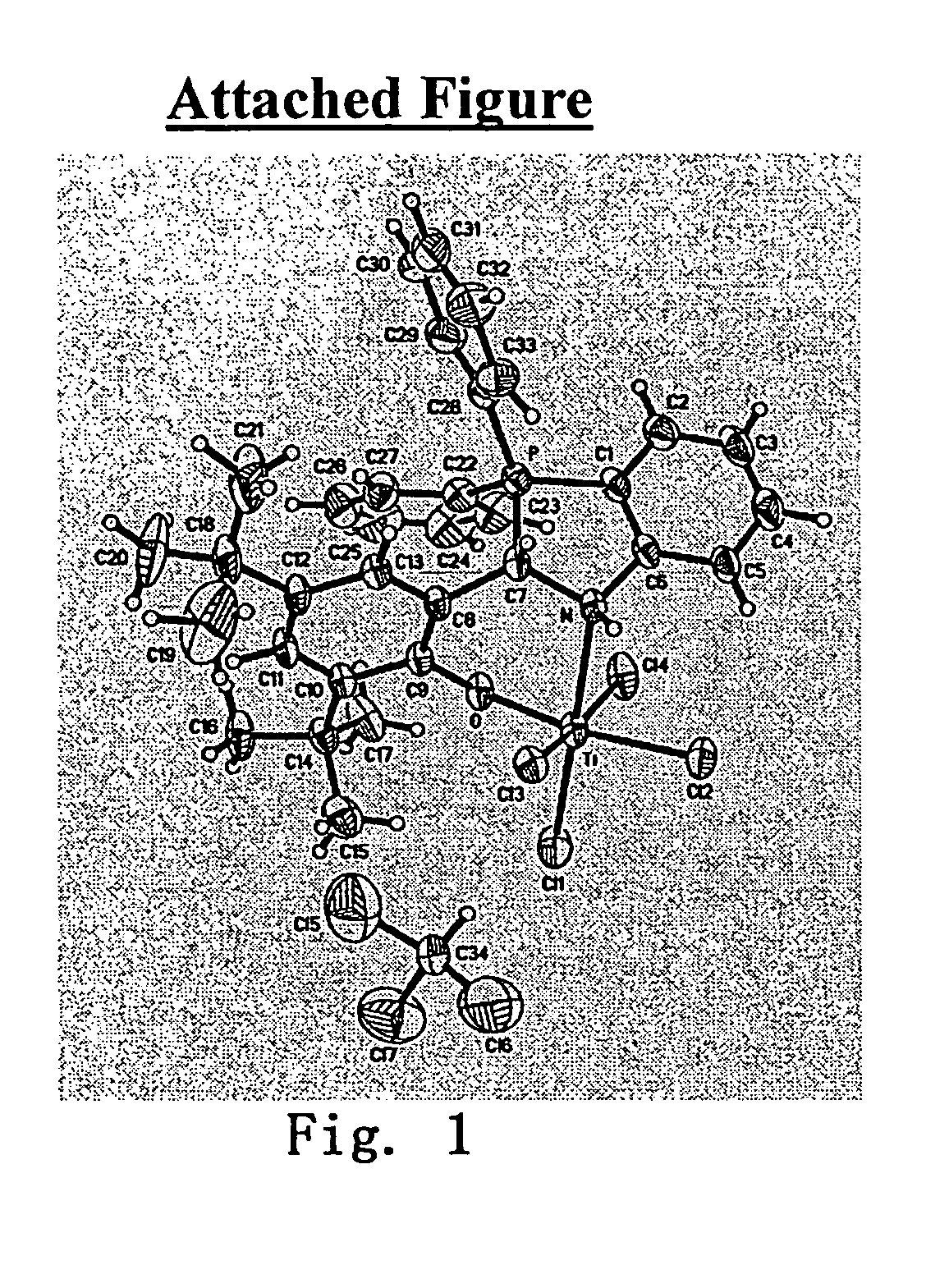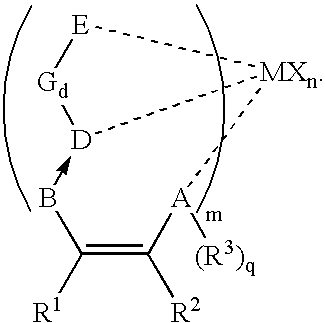Catalyst for polymerization or copolymerization of olefins, preparation and use of the same
a technology of polymerization or copolymerization, which is applied in the direction of catalyst activation/preparation, chemical/physical processes, group 8/9/10/18 element organic compounds, etc., can solve the problems of difficult control of the structure and physical properties of the polymer, and achieve high activity, high yield, and easy synthesized
- Summary
- Abstract
- Description
- Claims
- Application Information
AI Technical Summary
Benefits of technology
Problems solved by technology
Method used
Image
Examples
example 1
Synthesis of Ligand L1
[0148]To a solution of 3,5-di-tert-butyl salicyaldehyde 8.2 g (34.4 mmol) and (o-aminophenyl) diphenylphosphine 9.6 g (34.6 mmol) in anhydrous ethanol (50 ml) was added zeolite and a few drops of glacial acetic acid in a flask. After refluxing for 24 h, filtered the zeolite, the filtrate was concentrated, cooled to room temperature to give the crude product. Recrystallization from ethanol / ether gave the ligand L1 as pale yellow crystals, 11.8 g (69%).
[0149]
[0150]Anal. Found (calcd): C, 80.39 (80.29); H, 7.59 (7.35); N, 2.77 (2.84); 1H NMR (300 MHz CDCl3): δ8.4 (s, CH═N), 7.4-6.8 (m, Aryl-H), 1.4 (s, t-Bu-H), 1.3 (s, t-Bu-H); δ(31P)-13.63 (s).
example 2
Synthesis of Ligand L2
[0151]To a flask was added a solution of 3,5-di-tert-butyl salicyaldehyde 2.34 g (10.0 mmol) and (o-aminophenyl) diphenylamine 2.3 g (8.8 mmol) in anhydrous ethanol of 100 ml. After refluxing 24 h, the resulting mixture was cooled to room temperature to give the product, then washing with cool ethanol for several times and dried to give ligand L2 as yellow crystals, 3.5 g (81%).
[0152]
[0153]Anal.: Found (Calcd): C, 83.19 (83.15); H, 7.60 (7.61); N, 5.87 (5.88); 1H NMR (300 MHz CDCl3): δ13.6 (s, O—H), 8.6 (s, CH═N), 7.5-7.0 (m, Aryl-H), 1.5 (s, t-Bu-H), 1.3 (s, t-Bu-H).
example 3
Synthesis of Ligand L3
[0154]To a solution of 3,5-di-tert-butyl salicyaldehyde 2.34 g (10.0 mmol) and 2,6-di-methyl-phenyl-2-aminophenylether 2.13 g (10.0 mmol) in anhydrous ethanol 50 ml was added to a flask of 250 ml. After refluxing for 20 h, the resulting mixture was cooled to room temperature to give the crude product, washing with anhydrous ethanol for several times and drying to give ligand L3 as yellow crystals 2.9 g (81%).
[0155]
[0156]Anal.: Found (calcd): C, 80.86 (81.06); H, 8.13 (8.23); N, 3.23 (3.26); 1H NMR (300 MHz CDCl3): δ14.0 (s, O—H), 8.86 (s, CH═N), 7.46-6.43 (m, Aryl-H), 2.17(s, CH3), 1.50 (s, t-Bu-H), 1.31 (s, t-Bu-H).
PUM
| Property | Measurement | Unit |
|---|---|---|
| temperature | aaaaa | aaaaa |
| temperature | aaaaa | aaaaa |
| temperature | aaaaa | aaaaa |
Abstract
Description
Claims
Application Information
 Login to View More
Login to View More - R&D
- Intellectual Property
- Life Sciences
- Materials
- Tech Scout
- Unparalleled Data Quality
- Higher Quality Content
- 60% Fewer Hallucinations
Browse by: Latest US Patents, China's latest patents, Technical Efficacy Thesaurus, Application Domain, Technology Topic, Popular Technical Reports.
© 2025 PatSnap. All rights reserved.Legal|Privacy policy|Modern Slavery Act Transparency Statement|Sitemap|About US| Contact US: help@patsnap.com



